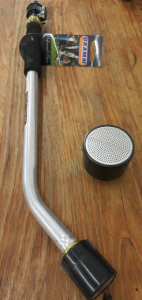
The sedum genus of more than 600 species are mainly low growing to about 10cm. Examples include Sedum “Purple Blob”, S. “Silver Blob”, S. “Gold Blob” and S. “Grey Blob”, all suitable for pots or hanging gardens, commonly known as Stonecrop or Live Forever plant. If you watch the TV show “Grand Designs” you will see them often used on environmental roofs.
THEN we have taller varieties such as S. “Dynamite”, which as the name suggests, has bright red flowers to 80cm tall x 60 cm. The most popular tall variety is Sedum spectabile “Autumn Joy” (pictured here on our nature strip), is native to China and Japan. This sedum can be found in almost every garden in Britain and Europe for its autumn colour and the ease of growing and propagation.
It is a super plant for children to grow. Simply put a stick in the ground next to the plant in late winter marked in centimetres and record each week how fast it grows.
The flower heads start as light green, gradually changing to pink, then deeper pink and finally in late autumn/early winter to bronze.
When the severe frosts arrive they will affect the tall flowers on the long stalks, at which time they should be cut to ground level.
Then the fascinating new growth starts immediately in mid-winter with soft, tiny, new shoots that are totally frost hardy. These tiny shoots, a couple of centimetres high’ continue to grow through winter and, by spring, are about 10cm tall. Growing steadily all summer to up to 40cm tall, when the first of the flowers start to form.
AN ideal companion plant for autumn flowering is the tough as nails salvia family, originating in Mexico. They are coming into flower now.
Like sedums they range from low-growing Salvia “Aztec Blue” to S. “Impact Purple” or S. “Impact Pink”, both growing to 40cm tall with a spread of 1m. There are other varieties that grow up to two metres with more than 40 varieties generally available in local garden centres in flower at this time.

Most sprinkler heads sold on the end of garden hoses with the adjustable nozzles are generally totally useless. The water wand and nozzle used by almost every commercial nursery here and overseas is the Dramm water wand. Delivering an even flow without damaging the most fragile plants this is ideal for watering pots and annuals.
It has two different sized heads depending on water pressure, which can vary enormously. Shown here are the two heads, the smaller if your water pressure is low and the larger head for high water pressure. Take into account that in hot weather pressure will be affected by everyone arriving home and watering, too.
Are they tough? My Dramm watering wands are now at least 35 years old!
As I have said numerous times, hand watering of trees and shrubs is generally a waste of time.
Jottings...
- This is caterpillar time and the bane of vineyards. Treat with Dipel, a natural bio-insecticide that is non-toxic to humans. Spray under leaves and the ground around the plants.
- Perennials that have finished flowering can be cut to ground level and divided for potting up or fillers for blank spaces.
- It’s time to plant seedlings of English spinach, so much more versatile than silver beet.
- Harvest pumpkins and leave to dry out before storing.
Who can be trusted?
In a world of spin and confusion, there’s never been a more important time to support independent journalism in Canberra.
If you trust our work online and want to enforce the power of independent voices, I invite you to make a small contribution.
Every dollar of support is invested back into our journalism to help keep citynews.com.au strong and free.
Thank you,
Ian Meikle, editor




Leave a Reply